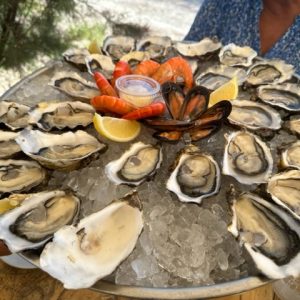Montpellier
Montpellier is situated 10 km inland from the Mediterranean coast in southern France, about 170 km west of Marseille and 750 km south of Paris. Any Australian will tell you that it should be right on the coast.
But Montpellier is a very beautiful city with the Place de la Comédie at its centre, surrounded by elegant buildings. What makes Montpellier distinctive is that it is a university town, with an excellent range of museums.
I have the good fortune to have some of my best friends living there, namely Marie-Francoise, and Gilles and Marie-Claire. Although Marie-Francoise was away on holidays, Gilles and Marie-Claire were there to offer me a spectacular visit of the region, including tasting the local wine.
We visited Sète, a port bordered by the Étang de Thau, a biodiverse saltwater lagoon. We went up Mont St Clair which offers views of the city, known as “Venice of the Languedoc” for its canal network.
Then we moved on to Pézenas, a beautiful old town with much of its medieval architecture intact. The old town centre with narrow streets are a delight to walk through. Pézenas has a very rich history including the possible visit of Molière and his theatre group l’Illustre Théâtre.
Perhaps the high point of the day was lunch at the Tarbouriech “Comptoirs de dégustation” where we consumed a giant plateau of Huîtres de Bouzigues (oysters), which are exclusively produced in the Bassin de Thau.
What better way to wash down these wonderful oysters than with “Le Picpoul de Pinet”, a wine produced on the lake of Thau.
Piquepoul, or Picapoll, is a variety of wine grape grown primarily in the Rhone Valley and Languedoc regions of France as well as in Catalonia, Spain. It exists both in dark-skinned (Piquepoul noir) and light-skinned (Piquepoul blanc) versions, as well as a very little grown Piquepoul gris. Piquepoul blanc is the most common of the Piquepouls.
Piquepoul may not be a great wine, but the white version that I tasted is a light, fresh and crisp wine that goes perfectly with oysters and other seafood.
Piquepoul reportedly has a long history in the Languedoc region. It is now being successfully grown in the US. Piquepoul blanc was first planted in Australia in 2013 and the first commercial release of wine was in 2017. Cuttings of the variety were imported for the wine’s suitability for drinking with oysters!
We were supposed to go wine walking after lunch. But under the influence of Piquepoul and the 34 degrees temperature, we decided to postpone walking until next time! Sorry!!





